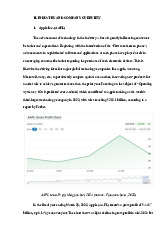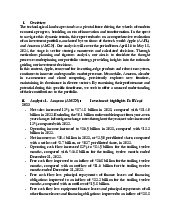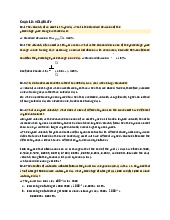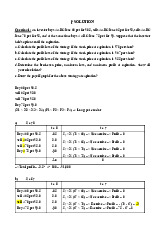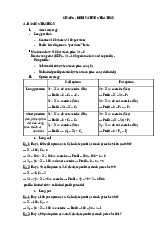









Preview text:
lOMoAR cPSD| 23136115
International University
School of Economics, Finance and Accounting COURSE SYLLABUS 1. General Information - Course Title: + Vietnamese:
Phái Sinh và Quản Lý Rủi Ro + English:
Derivatives and Risk Management - Course ID: BA216IU - Course level: ☒ Undergraduate ☐ Master ☐ Both ☐ General ☐ Fundamental Specialization (elective) - Course type: ☒ Specialization (required) ☒ ☐ Project/Internship/Thesis
☐ Others: ........................... - Number of credits: 3 + Lecture: 3 + Laboratory: 0 lOMoAR cPSD| 23136115 - Prerequisites:
BA207IU – Fundamental of Financial Management
BA134IU– Financial Institutions and Markets - Parallel Courses: None
- Course it replaces: None
2. Course Description and Objectives
This course provides an overview of the main characteristics of financial derivatives, essential
hedging techniques, and risk management strategies, including options, futures, and swaps. This
course is designed for students who plan to work in investment banks, investment funds, or multinational corporations.
3. Textbooks and Other Required Materials Textbooks:
Pirie, Wendy L., 2017, Derivatives (John Wiley & Sons, Inc: CFA Institute Investment Series)
Chance, Don M., 2002, Analysis of Derivatives for the CFA Program, CFA Institute Johnson,
R. Stafford, 2017, Derivatives Markets and Analysis (Bloomberg Press: Bloomberg Financial). Reference Textbooks:
Chance, D.M. & Brooks R., 2016, An Introduction to Derivatives and Risk Management (Cengage Learning)
Hull, John C., 2018, Options, Futures, and Other Derivatives (Pearson Education) Recommended Journals: Journal of Derivatives Journal of Future Markets Finance Analyst Journals lOMoAR cPSD| 23136115 Journal of Risk
Journal of Banking and Finance The Economist Financial World Wallstreet Journal Harvard Business Review
Useful Websites: https://finviz.com/
https://www.optionseducation.org/en.html
https://www.optionsbro.com/selling-call-options/ https://zerodha.com/varsity/
http://www.elearnoptions.com/strategylearn.html?id=Long www.ssrn.com Additional Materials:
The instructor makes lecture notes and assigns additional readings available on the Blackboard course site.
4. Course Learning Outcomes
After successful completion of this course, students will be able to:
LO1. Understand the scope of financial derivatives and the concept of risk transfer.
LO2. Understand the structure of derivatives markets and derivatives strategies.
LO3. Understand the strengths and weaknesses of using derivatives as a risk management tool.
LO4. Classify and compare different types of derivatives instruments.
LO5. Classify and demonstrate the application of hedging strategies.
LO6. Identify and evaluate the extent of financial risks that a company is facing.
LO7. Learn within teams (such skills as task assignment and management, conflict resolution and
cooperation, consensus building, and leadership).
LO8. Provide professional business presentations (both oral and written).
The alignment between course learning outcomes and program learning outcomes: lOMoAR cPSD| 23136115 Group of ....... Program learning
Course learning outcomes % of contribution outcomes (*) on PO Political & PO1 LO5 1% professional Knowledge PO2 LO1, LO2, LO3, LO4, LO5, 3% LO6 Analytical skills PO3 LO4, LO5, LO6 2% Communication PO4 LO6 1% skills Critical thinking PO5 LO4 2% skills Technology skills PO6 LO1 2% Ethical attitude at PO7 LO5 1% work Cognitive ability PO8 LO5 1% and perspectives on globalization Teamwork, PO9 LO7, LO8 1% selfstudying, and career development skills
Total % contribution of this course to the program learning outcome: 14%
(*) Refer to nine program objectives: lOMoAR cPSD| 23136115 a.
Knowledge: The students possess a solid knowledge relevant to Corporate Finance,
Banking, and Financial Investment. The program helps students understand the role of
financial markets and financial investment issues of individual and institutional investors,
fundamental theories in financial investment and financial investment operations, financial
management in view of enhancing corporate governance by meeting the legitimate
requirements of a stakeholder perspective and identify the important role of corporate finance
in the international business environment. (PO1) b.
Political perspective: The students understand fundamentally the structure and
principles of the Vietnamese political system and its orientation. (PO2) c.
Analytical skills: Finishing the program, students can manage portfolios of
profitability and risk; make policies and investment planning strategies for businesses as well
as investors; analyze the impact of macroeconomic policy (monetary finance) on the financial
market as well as on financial investment; set financial plans and provide financial
management information for decision making of the management. (PO3) d.
Communication skills: The students demonstrate an ability to communicate effectively
using appropriate communication methods with domestic and international audiences. They
are able to communicate effectively in English in all forms of communication, such as writing,
presenting, organizing, and sharing information. (PO4) e.
Critical thinking skills: The students understand related issues from multiple
perspectives, interpret information effectively, and give sound judgment. (PO5) f.
Technology skills: The students understand how to apply effectively and efficiently
appropriate technologies to business and communication settings. (PO6) g.
Ethical attitude at work: The students develop an awareness of the ethical dimensions
of communication, behavior, and decision-making at the workplace. (PO7) h.
Cognitive ability and perspectives on globalization: The students are sensitive to
opportunities and challenges of globalization and are responsive to cross-cultural issues that
influence business operations in the global context so as to take advantage of global
opportunities and overcome challenges. (PO8) lOMoAR cPSD| 23136115 i.
Teamwork, self-studying, and career development skills: The students are effective
team members who are able to and willing to support others, become successful team leaders,
pursue lifelong study, and have future-oriented perspectives. They learn and respect
colleagues' abilities and contributions and are willing to take responsibility for their behavior
and actions. (PO9) 5. Course Assessment 5.1 Grading Assessment component Assessment form Percentage (%) A1. Attendance A1.1 Attendance 5% A2. Course Project
A2.1 Presentations and Discussions 25% A2.2 Group Project 10% A3. Mid-term Exam A3.1 Mid-term Exam 30% A4. Final Exam A4.1 Final Exam 30% Total 100%
A.1.1 Attendance: Regular and punctual attendance at lectures and seminars is expected in this
course. The students will get a full score for this section if they attend all lectures and seminars.
Each absence may lower 20% of the student’s grade. According to the University regulation,
students are not allowed to have more than three absences
A2.1 Paper/Case Study Presentations: Each group of 3-4 students is assigned to present 1-2
articles/case studies. Detailed guidelines will be provided in class. The assessment of this section
is based on how relevant information in the articles/case studies is appropriately presented in 1520
minutes. Remember that each student in the group is supposed to present at least a part of the
article/case orally to the instructor. For the assignment description, I would talk more about what
students are supposed to do more than assessment because such detailed information will be
explained in great detail in guidelines. lOMoAR cPSD| 23136115
A2.2 Group project: Each group of 3-4 students is required to complete a project and present it in
the final 2 weeks of the course. The detailed guidelines of the project will be provided in an
assignment packet. The grade of the project will be determined by the total points the students
earned from the various assessment components as described as follows:
(1) Writing up a report: Your reports must be highly informative (“informative” should be
stated in detail, such as what makes a report informative), showing a deep understanding
of the process, completing calculations, and making a rational recommendation. A report is expected to:
- have the Cover Sheet Group Assignment.
- not exceed 15 pages but may include an appendix of infinite length.
- be the original work of the team members.
(2) Presentation: is based on the presentation. Your presentation should be professional to get
a high grade for this part. Remember that each student in the group must present at least a
part of the case orally to the instructor.
The presentation is limited to 20 minutes. When the time has expired, the team must
immediately stop the presentation. An additional 10 minutes will be provided to answer
questions posed by the instructor.
A.3.1 Midterm Exam and A.4.1. Final Exam: The exams will be 90-minute closed book ones.
All materials covered in the course are examinable, and more points are rewarded for critical
thinking. Further exam details will be announced one week before the exam dates. The exams may
ask 1-2 questions related to the paper/case study and the group project.
The Office of Undergraduate Academic Affairs will announce the examination schedule. Any
issues regarding administration, timetabling, and nonattendance at the examinations need to be
directed to the Office of Undergraduate Academic Affairs. These issues are not the responsibility of the instructor. 5.2 Assessment Plan
No. Assessment tasks Learning Outcome
Level of Bloom taxonomy Weight Applying (%) Analyzing Evaluating Creating lOMoAR cPSD| 23136115
MCQ WQ P MCQ WQ P MC WQ P MCQ W P (**) Q Q 1 A1, A2, A3, A4 LO1 x x x x x x x x x x x 15 2 A1, A2, A3, A4 LO2 x x x x x x x x x x x 15 3 A1, A2, A3, A4 LO3 x x x x x x x x x x x 15 4 A1, A2, A3, A4 LO4 x x x x x x x x x x x 15 5 A1, A2, A3, A4 LO5 x x x x x x x x x x x 10 6 A1, A2, A3, A4 LO6 x x x x 10 7 A1, A2, A3, A4 LO7 x x x x x x x x 20 Total 100
(**) MCQ: Multiple-choice questions; WQ: Writing questions; P: Presentation 6. Course Outline Week Topics Contents/Chapters 1 Derivative Markets and Pirie (2017) Chapter 1 Instruments Chance (2002) chapter 1 Group project overview Group formed 2
Basics of Derivative Pricing Pirie (2017) Chapter 2 and Valuation Chance (2002) chapter 3,4,5 3 Pricing and Valuation of Pirie (2017) Chapter 3 Forward Commitments Chance (2002) chapter 3,4,5 4-9 Derivatives Strategies Pirie (2017) Chapter 5 Johnson (2017) 1-4, 5, 7, 14 Chance (2002) chapter 3,4,5 CBOE Online Courses lOMoAR cPSD| 23136115 10 Risk Management Pirie (2017) Chapter 6 Chance (2002) chapter 9 11 Risk Management Pirie (2017) Chapter 7 Applications of Forward and Futures Strategies Chance (2002) chapter 6 12 Risk Management Pirie (2017) Chapter 8 Applications of Option Strategies Chance (2002) chapter 7 13 Risk Management Pirie (2017) Chapter 9 Applications of Swap Strategies Chance (2002) chapter 8 14-15 Group presentations
Note: Detailed schedule to be informed later Final Examination 7. Course Policies 1.1 Workload
Student responsibility: The students are expected to spend at least TEN hours per week
reading materials, working on exercises and problems, and attending classes.
Missed tests: The students must submit all their assignments and attend all their examinations
scheduled for the course. I do not consider any special request unless you suffer from illness
or misadventure affecting your course progress. 1.2
General Conduct and Behavior
Beepers, cell phones, and pagers need to be turned off before the class starts. The students are
expected to conduct themselves with consideration and respect for the needs of their fellow
students and the teaching assistant. Conduct that unduly disrupts or interferes with a class,
such as ringing or talking on mobile phones, is unacceptable, and students will be asked to leave the class. lOMoAR cPSD| 23136115 1.3 Keeping Informed
The students should take note of all announcements made in lectures or on the course’s
Blackboard. From time to time, the university will send important announcements to their
university e-mail addresses without providing a paper copy. The students will be deemed to
have received this information. 1.4 Academic dishonesty
Plagiarism: The students are required to submit their group project to Turnitin. The similarity
index for the whole report (a certain source) should be not more than 15% (2%). Cheating:
Cheating in any form in the exams is prohibited. If the students violate this rule in any exam,
they will get a zero for that exam.
2. Course Coordinator / Instructor
- School / Department: School of Economics, Finance, and Accounting/Department of Finance and Banking
- Course Coordinator / Instructor: Vo Xuan Hong - Email: vxhong@hcmiu.edu.vn
HEAD OF DEPARTMENT
Ho Chi Minh City, January 15, 2023
DEAN OF THE SCHOOL OF ECONOMICS,
FINANCE AND ACCOUNTING
